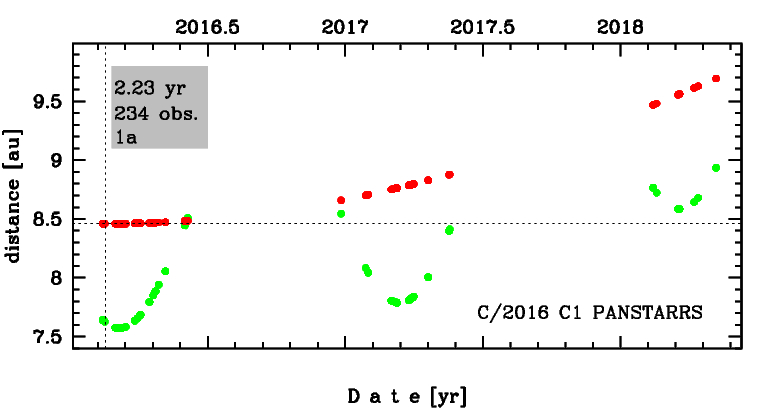C/2016 C1 PANSTARRS
more info
Comet C/2016 C1 was discovered on 12 February 2016 with Pan-STARRS 1 telescope (Haleakala), that is a week before its perihelion passage. This comet was observed until 24 May 2020.
Comet had its closest approach to the Earth on 5 March 2016 (7.572 au), about 2 weeks after its perihelion passage.
The preferred solution given here is based on data spanning over 4.28 yr in a range of heliocentric distances: 8.46 au – 8.46 au (perihelion) – 12.3 au.
This Oort spike comet suffers small planetary perturbations during its passage through the planetary system; however, these perturbations likely lead to escape the comet from the planetary zone on a hyperbolic orbit (see future barycentric orbits).
Comet had its closest approach to the Earth on 5 March 2016 (7.572 au), about 2 weeks after its perihelion passage.
The preferred solution given here is based on data spanning over 4.28 yr in a range of heliocentric distances: 8.46 au – 8.46 au (perihelion) – 12.3 au.
This Oort spike comet suffers small planetary perturbations during its passage through the planetary system; however, these perturbations likely lead to escape the comet from the planetary zone on a hyperbolic orbit (see future barycentric orbits).
| solution description | ||
|---|---|---|
| number of observations | 234 | |
| data interval | 2016 02 12 – 2018 05 06 | |
| data type | significantly more measurements after perihelion (POST+) | |
| data arc selection | entire data set (STD) | |
| range of heliocentric distances | 8.46 au – 8.46 au (perihelion) – 9.69 au | |
| detectability of NG effects in the comet's motion | NG effects not determinable | |
| type of model of motion | GR - gravitational orbit | |
| data weighting | YES | |
| number of residuals | 464 | |
| RMS [arcseconds] | 0.56 | |
| orbit quality class | 1a | |
| orbital elements (heliocentric ecliptic J2000) | ||
|---|---|---|
| Epoch | 2016 02 22 | |
| perihelion date | 2016 02 16.39163838 | ± 0.00316622 |
| perihelion distance [au] | 8.45936414 | ± 0.00001502 |
| eccentricity | 1.00491445 | ± 0.00000967 |
| argument of perihelion [°] | 328.569874 | ± 0.000179 |
| ascending node [°] | 181.781050 | ± 0.000007 |
| inclination [°] | 56.178662 | ± 0.00002 |
| reciprocal semi-major axis [10-6 au-1] | -580.95 | ± 1.14 |
